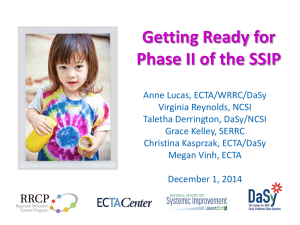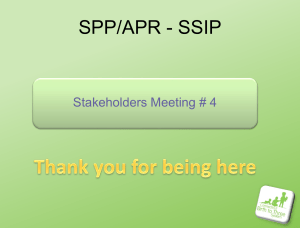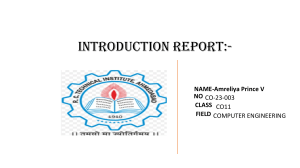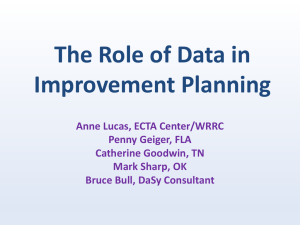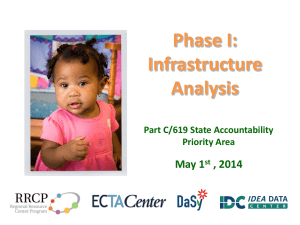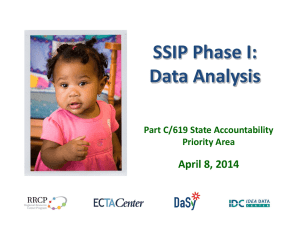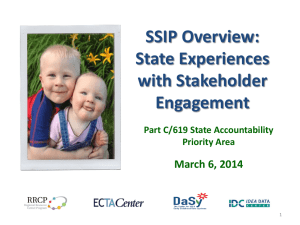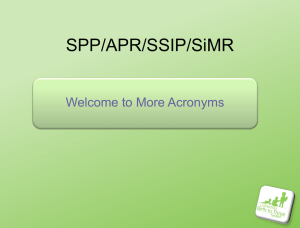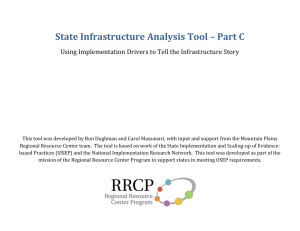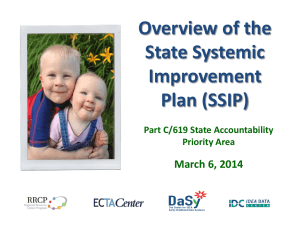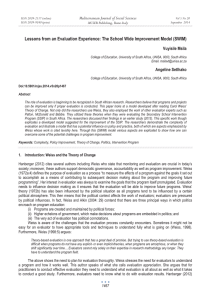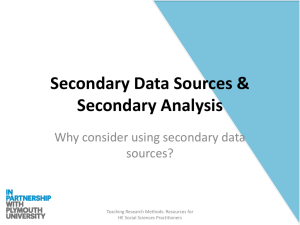SSIP Phase I and II
advertisement
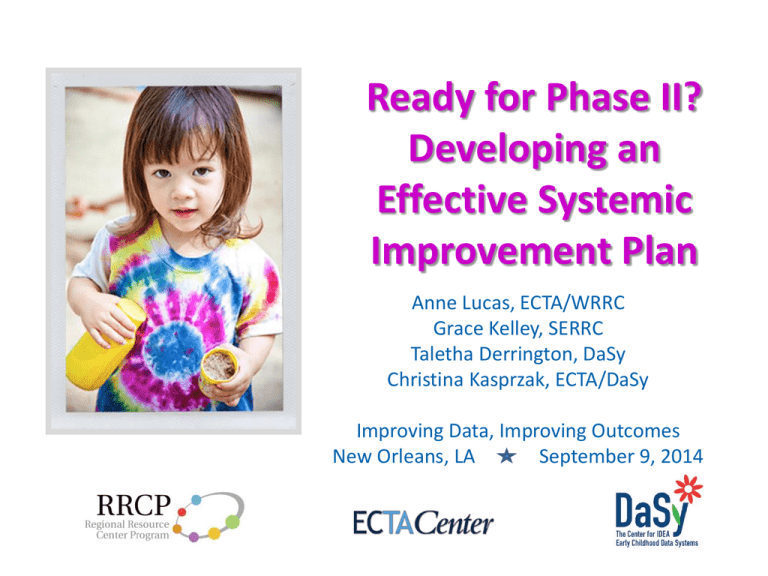
Ready for Phase II? Developing an Effective Systemic Improvement Plan Anne Lucas, ECTA/WRRC Grace Kelley, SERRC Taletha Derrington, DaSy Christina Kasprzak, ECTA/DaSy Improving Data, Improving Outcomes New Orleans, LA September 9, 2014 Session Outline • • • • • Overview of Phase II Developing a good improvement plan Implementation Science Evaluation Discussion 2 OVERVIEW OF PHASE II 3 Proposed SSIP Activities by Phase Year 1 - FFY 2013 Delivered by Apr 2015 Year 2 - FFY 2014 Delivered by Feb 2016 Years 3-6 Phase I Analysis Phase II Development Phase III Evaluation and Implementation • Data Analysis; • Description of Infrastructure to Support Improvement and Build Capacity; • State-identified Measureable Result; • Selection of Coherent Improvement Strategies • Theory of Action • Multi-year plan addressing: • Infrastructure Development; • Support EIS Program/LEA in Implementing Evidence-Based Practices; • Evaluation Plan • Reporting on Progress including: • Results of Ongoing Evaluation • Extent of Progress • Revisions to the SPP FFY 2015-18 Feb 2017- Feb 2020 4 Evaluation • Evaluation of progress annually • Adjust plan as needed SSIP Phase III How well is the solution working? Analyzing and Focusing •Identify starting point • Initiate broad Data Analysis • Conduct broad Infrastructure Analysis • Identify primary concern (potential SiMR) What is the problem? SSIP Phase I SSIP SSIP Phase I and II Planning and Doing • Identify coherent improvement strategies (Exploration Phase) • Develop action steps (address barriers/use leverage points) • Develop Theory of Action • Develop Plan for improvement (Implementation Framework) What shall we do about it? Why is it happening? SSIP Phase I • Investigating • Conduct root cause analysis (including infrastructure) to identify contributing factors • For each contributing factor, identify both barriers and leverage points for improvement • Narrow and refine the SiMR Phase II - Improvement Plan: Infrastructure Development Infrastructure development includes: • Improvements to infrastructure to better support EIS programs/LEAs to scale up evidence-based practices to improve SiMR – Who will implement infrastructure changes – Resources needed – Expected outcomes – Timelines 6 Phase II - Improvement Plan: Infrastructure Development Infrastructure development includes (cont’d): • Identify steps to further align/leverage current improvement plans/initiatives • How to involve other LA/SEA offices and other agencies 7 Phase II - Improvement Plan: Evidence-based Practices Support for implementing evidence-based practices includes: • Activities supporting implementation of strategies including: – Communication strategies and stakeholder involvement – How identified barriers will be addressed – Who will be in charge of implementing – How activities will be implemented with fidelity 8 Phase II - Improvement Plan: Evidence-based Practices • Activities include (cont’d): – Resources that will be used – How expected outcomes of strategies will be measured – Timelines • How multiple offices/other state agencies will be involved to support LEAs/EIS programs in scaling up and sustaining evidence-based practices implemented with fidelity 9 Phase II - Improvement Plan: Evaluation • The plan to evaluate implementation includes: – Short-term and long-term objectives to measure implementation and impact on results – Long-term objectives for children exiting Part C • Plan must be aligned with: – Theory of Action – Other components of SSIP 10 Phase II - Improvement Plan: Evaluation • Plan must include: – How stakeholders will be involved – Methods to collect and analyze data on activities and outcomes – How State will use evaluation results to: • • • • Examine effectiveness of implementation plan Measure progress toward achieving intended outcomes Make modifications to plan How results of evaluation will be disseminated 11 SSIP Components • The SSIP components are not linear • Information from one component feeds other components and it is often necessary to “loop back” to a previous component 12 Planning is something you do so when you do something it is not all messed up Christopher Robin to Winnie the Pooh DEVELOPING A GOOD IMPROVEMENT PLAN 13 What is Planning ? • Planning is an organizational management activity that is used to: – Set priorities – Focus energy and resources – Ensure that employees and other stakeholders are working toward common goals – Establish agreement around intended outcomes/results 14 Why an SSIP Plan? • Your plan will define how you will achieve measureable results for infants and toddlers by strengthening your infrastructure, and implementing evidenced based practices. – Based on stakeholder input – Builds on all of the information gathered during Phase 1 15 Why an SSIP Plan? Your plan will define how you will implement SSIP, including: • Identification of the improvement strategies, mechanisms and resources for implementing the improvement activities • The timelines for beginning and completing the improvement strategies Strategies Activities with timelines 16 What Results will Your Plan Achieve? Governance Result: Finance Quality Standards Implementation of effective practices Good outcomes for children with disabilities and their families Personnel / Workforce Accountability & Quality Improvement Data Systems 17 Begin with the End in Mind What are the desired results or outcomes for children and/or families ? Achieve the SiMR 18 How do We Prepare Staff and Sustain System/Practice Change? What activities will be implemented to ensure practitioners have relevant knowledge and implement aligned practices? Professional Development/Leadership 19 How do we support systems/practice change on a day to day basis What activities will be implemented to ensure effective training, TA, coaching and other supports related to desired practices ? Support for Practice 20 Local Support of Systems/Practice Change What activities will be implemented to ensure local systems support practitioners? Local supports 21 State Support of System/Practice Change What activities will be implemented to ensure state system supports local systems and implementation of desired practices? State Support 22 What Activities Support the Strategies and Implement the Theory of Action? What activities What activities What activities What activities What are the will be will be will be will be desired results implemented to implemented to implemented to implemented to or outcomes for ensure state ensure local ensure ensure children and/or system systems effective practitioners families ? supports local support training, TA, have relevant systems and practitioners? coaching and knowledge implementation other and of desired supports implement practices? related to aligned desired practices? practices ? State Supports Local supports Support for Practice Professional Development Achieve the SIMR 23 Short and Long Term Strategies/ Objectives Objectives are the defined steps that help achieve the goal: • Short Term Objectives – incremental steps with shorter timeframes that move an organization toward their goals usually accomplished in 1-3 years • Long Term Objectives- Performance measures to be achieved over a period of five years or more 24 Set Targets • Targets ~ specific numbers you intend to meet in order to achieve the goals over the time period of the SSIP • They can be incremental increases or maintain progress 25 Clear Strategies/Actions to be Implemented – Should address issues at all levels of the system – Address aspects of the infrastructure that must be improved including resources needed and timelines – Address how they will be aligned with initiatives and current improvement plans – Activities must be connected and reflect the root causes impacting the SiMR – Identify communication strategies (to facilitate buy in) and stakeholder involvement 26 Develop Improvement Activities: • Improvement Activities are the specific actions that lead to the measurable results of your program. • Activities are SMART: –Specific –Measurable –Attainable –Realistic –Timed 27 Resources • http://ctb.ku.edu/en/table-ofcontents/structure/strategic-planning/createobjectives/main • http://www.hfrp.org/publicationsresources/browse-our-publications/strategicplanning-process-steps-in-developingstrategic-plans 28 IMPLEMENTATION SCIENCE 29 Implementation Science Active Implementation Frameworks WHEN WHO WHAT Teams Stages HOW HOW Usable Interventions Drivers Cycles http://sisep.fpg.unc.edu/ http://implementation.fpg.unc.edu/ 30 Consider Implementation Science: Implementation Drivers Performance Assessment (Fidelity) Coaching Systems Intervention Training Facilitative Administration Decision Support Data System Selection Leadership © Fixsen & Blase, 2008 Technical Adaptive 31 Consider Implementation Science: Implementation Drivers Resource Implementation Drivers: Assessing Best Practice http://implementation.fpg.unc.edu/sites/implementation. fpg.unc.edu/files/resources/NIRN-EducationImplementationDriversAssessingBestPractices.pdf 32 The Hexagon An EBP Exploration Tool The “Hexagon” can be used as a planning tool to evaluate evidencebased programs and practices during the Exploration Stage of Implementation. • Academic & socially significant Issues • Parent & community perceptions of need • Data indicating need Capacity to Implement • • Staff meet minimum qualifications Able to sustain Imp Drivers • Financially • Structurally Buy-in process operationalized • Practitioners • Families • Download available at: Need in local programs, state www.scalingup.org/tools-and-resources NEED Fit with current Initiatives • Local program, state priorities • Organizational structures Community values CAPACITY FIT EBP: 5 Point Rating Scale: High = 5; Medium = 3; Low = 1. Midpoints can be used and scored as a 2 or 4. High Med READINESS Low Fit Resources and supports for: Readiness for Replication • • • • • • Need RESOURCES Qualified purveyor Expert or TA available Mature sites to observe Several replications How well is it operationalized? Are Imp Drivers operationalized? EVIDENCE Resource Availability • • • • • • • Curricula & Classroom Technology supports (IT dept.) Staffing Training Data Systems Coaching & Supervision Administration & system Evidence Evidence Readiness for Replication Capacity to Implement •Outcomes – Is it worth it? •Fidelity data •Cost – effectiveness data •Number of studies •Population similarities •Diverse cultural groups •Efficacy or Effectiveness Total Score 33 © National Implementation Research Network 2009-2012 Adapted from work by Laurel J. Kiser, Michelle Zabel, Albert A. Zachik, and Joan Smith at the University of Maryland Some Ideas to Consider The SSIP cannot thrive in a vacuum - EIS/special education state agencies will not be successful if the SSIP is disconnected from the agency’s focus and work. 34 Some Ideas to Consider The SSIP should be aligned to and integrated with other initiatives in the state. – Supports leveraging of resources - greater influence – Prevents duplication of efforts – Builds momentum and capacity – Improves results 35 EVALUATION Evaluating the Implementation • Built into the plan from the beginning • Based on your theory of action • Based on data that informed the plan development • Formative data and summative data • Evidence to show progress 37 Evidence of Progress 1. Activities occurred and intended outcomes of each activity accomplished 2. Changes are occurring at the system, practice, and child/family level 38 For Each Activity... • Did the activity occur? – If yes, what are evidences that it occurred? – If not, why not? – What do we need to do next? • Did it accomplish it’s intended outcomes? – If yes, what are evidences that it accomplished intended outcomes? – If not, why not? – What else do we need to do before we move to the next activity? 39 If the Activity is an Output/Product e.g. Guidance Document • How will we know if the activity occurs? – Evidences, e.g. • guidance document developed and disseminated to the field • what else? • How will we know if the activity accomplishes the intended outcomes? – Evidences, e.g. • feedback from the field about whether the guidance document is clear, readily available, helpful, etc. • what else? 40 If the Activity is a Process e.g. Training for Practitioners • How will we know if the activity occurs? – Evidences, e.g. • training agenda, materials, activities • participation records • what else? • How will we know if the activity accomplishes the intended outcomes? – Evidences, e.g. • participant evaluations • measure of competencies • what else? 41 Evaluation at All Levels Governance Result: Finance Quality Standards Implementation of effective practices Good outcomes for children with disabilities and their families Personnel / Workforce Accountability & Quality Improvement Data Systems 42 For Each Level... • What are the guiding evaluation questions? • What will be our performance measure to know we’ve been successful? • What are the data sources for the performance measure? 43 Measuring Results • Results question, e.g.: – Have child outcomes improved? • Performance measure, e.g.: – % of children exiting at age expectations in social emotional functioning • Data source, e.g.: – Current state approach to C3/B7 measure of child outcomes 44 Measuring Practices • Practice-level questions, e.g.: – Have practices improved? Are more practitioners implementing the desired practice(s)? • Performance measure, e.g.: – % of practitioners implementing the desired practice – % of programs with 80% or more practitioners implementing the practice • Data sources, e.g. – Pre/Post measures of practices such as: • • • • • Fidelity check lists Supervisory observation of practices Monitoring data on practice implementation Self-assessment data on practices IFSP/IEP data What else? 45 Measuring Local Capacity • Local system-level questions, e.g.: – How has the local infrastructure been improved to support implementation of the practices? • Performance measure, e.g.: – Changes to local systems (governance, finance, personnel—TA and PD, data systems, accountability and quality improvement, quality standards). • Data sources, e.g.: – A local leadership team is established to support the new initiative – A local strategic plan is developed to align with state priority and strategic plan – Mentoring and supervisory system set up for supporting the practice – New supervisory checklist developed for observing and supporting practitioners’ implementation of the practice What else? 46 Measuring State Capacity • State system-level questions, e.g.: – How has the state infrastructure been improved to support implementation of the practices? • Performance measure, e.g.: – Changes to state systems (governance, finance, personnel—TA and PD, data systems, accountability and quality improvement, quality standards). • Data sources, e.g.: – Statewide communication plan created to inform all relevant stakeholders about new state priorities and strategic plan – Revised fiscal policy to reduce barriers to implementation of the practice – New monitoring process established to gather data on the practice What else? 47 Questions • What do you see as your biggest challenge(s) related to evaluating your SSIP? • What resources or supports will you need related to evaluating your SSIP? 48 Moving From Phase I to Phase II 1. What are your needs in moving from Phase I to Phase II? This includes linking coherent improvement strategies, TOA with the plan) 2. What are your needs for planning the development of the improvement plan? 3. What are your needs related to the content of the plan specific to Infrastructure Development? 4. What are your needs related to the content of the plan specific to supporting LEAs/EIS Programs implementation of evidence-based practices? 49 Thank you! • • • • Anne Lucas, anne.lucas@unc.edu Grace Kelley, gkelley3@cox.net Taletha Derrington, taletha.derrington@sri.com Christina Kasprzak, christina.kasprzak@unc.edu 50
